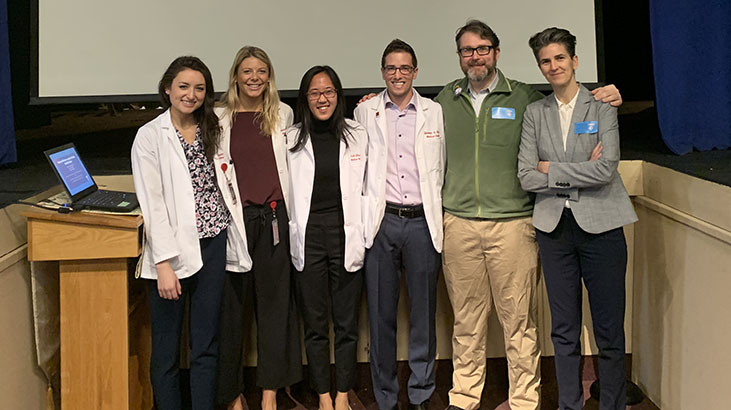
Teen vaping has become an epidemic and the numbers are staggering. According to the Centers for Disease Control and Prevention, the number of high school students who have used e-cigarettes in the past 30 days more than doubled from 11.7% in 2017 to 27.5% in 2019. And, among middle school students, the number more than tripled, increasing from 3.3% to 10.5%. In 2019, EVALI (e-cigarette or vaping product use-associated lung injury) was first described as healthcare providers and patients alike scrambled to understand its cause and impact.
“What we are seeing are two distinct but related epidemics, the surge in youth vaping and the recognition of EVALI,” says Jamie Garfield, MD, Associate Professor of Thoracic Medicine and Surgery at the Lewis Katz School of Medicine. “These epidemics are evolving rapidly and under the scrutiny of the public eye. I strive to make myself an expert on a subject where there is little clarity but scores of concerned people.”
After publishing an editorial in the Annals of Internal Medicine with Randol Hooper, MBBS, MS, a fellow in Thoracic Medicine and Surgery, and then interviewing on the local news on the epidemic of vaping, Dr. Garfield was approached by the Pennsylvania Department of Health and asked to lead an outreach program on vaping education for schools in the Philadelphia area. She eagerly agreed.
“A large part of my job is working with medical students,” Dr. Garfield explains. “I saw this as an opportunity to allow burgeoning health professionals to practice teaching while educating adolescents in the community. I knew the medical students would be excellent ambassadors to deliver this message to middle- and high-school students since they are closer in age to their audience. A lot can be lost when information is presented to teens by older authority figures.”
Dr. Garfield put the message out that she was looking for medical students interested in being part of the vaping outreach program and was quickly able to assemble a team of about 10 volunteers to help create and present the material.
The presentations last about 35 to 40 minutes and are followed by a 20-minute Q&A which, according to Dr. Garfield, runs over time each session because the teens have so many questions. To engage the young audiences, the presentation includes slides, videos and interactive polling.
“The presentations have been really well received, even better than I expected,” says second year medical student Allie Fales. “I’ve done three presentations so far and I’ve been impressed with the level of interest the teens have shown and the questions they’re asking. Many of them are very concerned because they have family members or friends who are vaping, and they want to know the facts.”
“I didn’t realize how much vaping was affecting younger people,” adds Jeremy Klein, also a second-year medical student. “The hardest part about our presentation is keeping up with new information. There is still so much that is unknown. We aim to be credible sources of information that the teens can relate to.”
“The unknown leads to a lot of rumors that aren’t necessarily true,” agrees second-year student Katey Steinberg. “These presentations are coming at a really good time; the information is so new and it’s really helpful that we’re not much older than the teens we’re presenting to. Hopefully they look at us and see how relevant the information is – that we’re coming at it from a cause of concern.”
All three students agree that being part of this program has been one of the best experiences of their medical school journey so far. They say they’ve gained public speaking skills and the ability to present medical information in a way that can be understood by a non-medical audience. They also value the experience they’ve had gathering information and collaborating with their peers and Dr. Garfield to create something relevant.
“Dr. Garfield is a great leader and she’s very relatable to us as medical students,” Klein says. “She’s so good at teaching and explaining things. That’s part of the reason I got involved.”
Dr. Garfield and her team of students have given their vaping presentation to six local public schools since the program began last November, with two more on the schedule.
“Every time we do a presentation another one pops up,” Steinberg says. “This topic is so timely and interest in our presentation spreads by word of mouth.”
“I’m really proud of the work we’re doing,” Dr. Garfield says. “I think this is only the beginning for us being out in the community as Temple doctors and medical students. It takes a bit of coordinating, but I’m happy to continue doing more presentations. I feel really privileged to be part of this program.”
Top photo caption: Pictured (l to r) at a vaping presentation are Katey Steinberg, Allie Fales, Liti Zhang, Jeremy Klein, Dr. Randol Hooper and Dr. Jamie Garfield.
